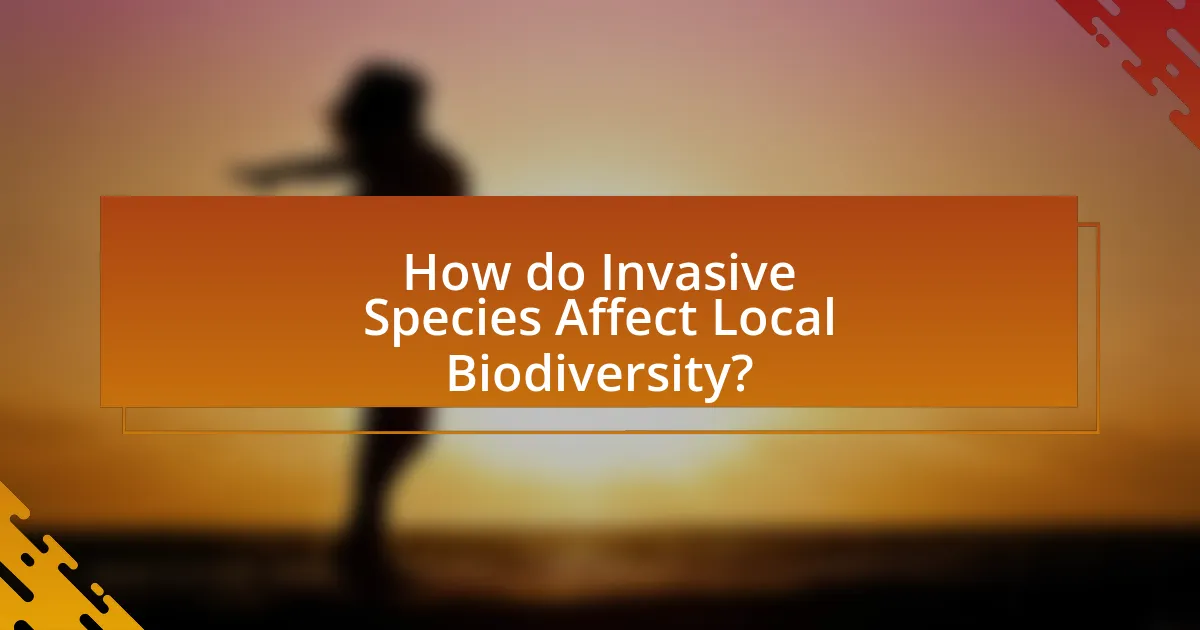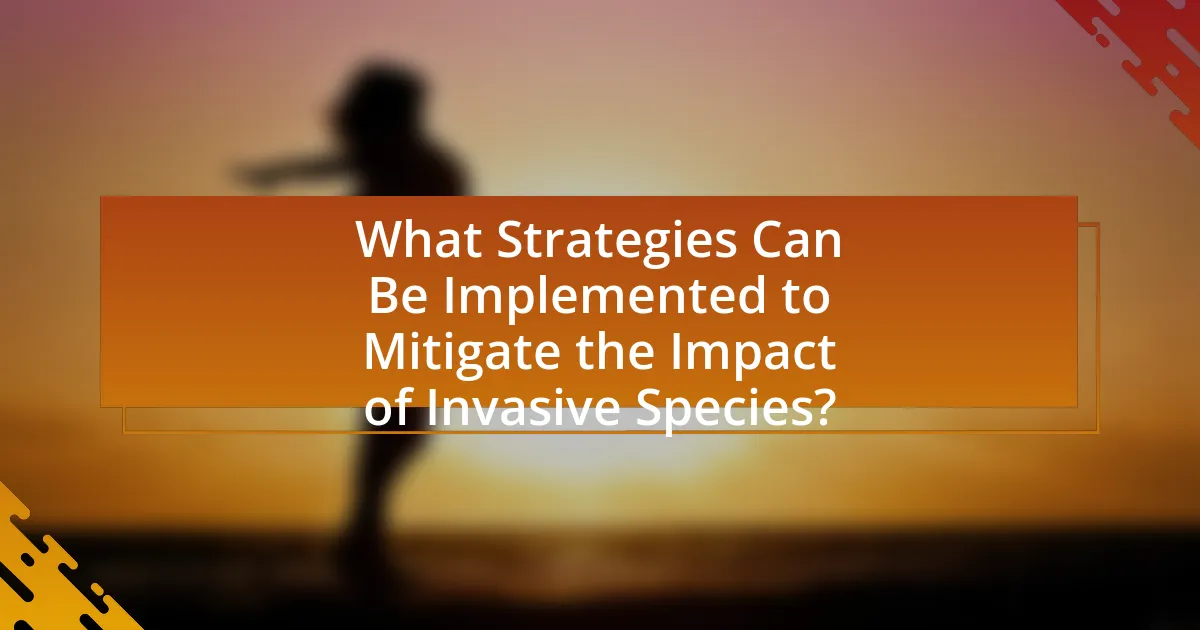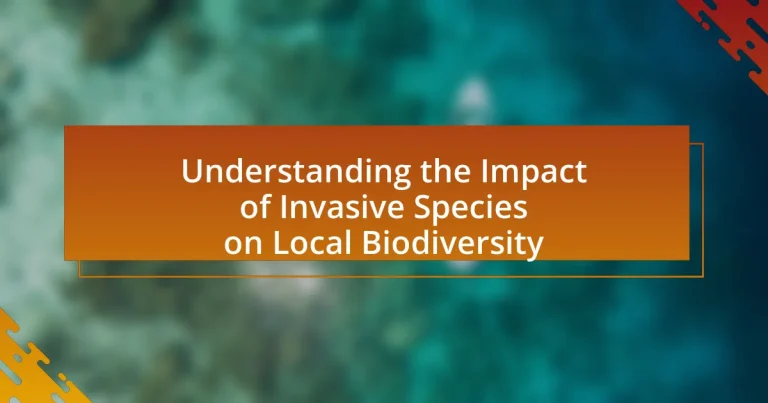Invasive species are non-native organisms that disrupt local ecosystems and biodiversity by outcompeting native species for resources, leading to declines or extinctions. This article examines the characteristics of invasive species, their introduction pathways, and the significant ecological impacts they have on local biodiversity, including alterations to habitat structures and food webs. It also discusses the role of human activity in spreading invasive species, the importance of monitoring and management strategies, and the potential long-term consequences for ecosystems. Effective control measures and community involvement are highlighted as essential for mitigating the adverse effects of invasive species on biodiversity.

What are Invasive Species and Their Role in Ecosystems?
Invasive species are non-native organisms that, when introduced to a new environment, disrupt local ecosystems and biodiversity. These species often outcompete native species for resources such as food, space, and light, leading to declines or extinctions of indigenous populations. For example, the introduction of the zebra mussel in North America has caused significant ecological and economic impacts by outcompeting native mussels and altering aquatic ecosystems. Invasive species can also introduce diseases to which native species have no immunity, further threatening their survival. The role of invasive species in ecosystems is primarily negative, as they can lead to reduced biodiversity and altered habitat structures, ultimately affecting ecosystem services.
How do invasive species differ from native species?
Invasive species differ from native species primarily in their origin and ecological impact. Invasive species are non-native organisms introduced to an ecosystem, often causing harm to local biodiversity, while native species are those that naturally occur in a specific region and have adapted to its environment over time. For instance, the introduction of the zebra mussel in North America has led to significant declines in native mussel populations and altered aquatic ecosystems, demonstrating the detrimental effects invasive species can have on local biodiversity.
What characteristics define an invasive species?
An invasive species is characterized by its ability to establish, spread, and cause harm to the environment, economy, or human health in a new habitat. These species often reproduce rapidly, outcompete native species for resources, and lack natural predators in their introduced environments. For example, the zebra mussel, introduced to North America in the 1980s, proliferated quickly, disrupting local ecosystems and causing significant economic damage by clogging water intake systems.
Why are some species more invasive than others?
Some species are more invasive than others due to their biological traits, adaptability, and the environments they invade. For instance, species like the zebra mussel possess rapid reproduction rates and can thrive in diverse habitats, allowing them to outcompete native species for resources. Additionally, invasive species often lack natural predators in their new environments, which further enhances their ability to proliferate. Research indicates that species with high reproductive rates, broad diets, and the ability to tolerate various environmental conditions are more likely to become invasive, as seen in studies of the Burmese python in Florida, which has disrupted local ecosystems due to its size and adaptability.
What are the pathways through which invasive species are introduced?
Invasive species are introduced through several primary pathways, including international trade, transportation, and human activities. International trade facilitates the movement of goods and organisms, often leading to the accidental introduction of non-native species. Transportation methods, such as ships and airplanes, can inadvertently carry invasive species in ballast water or on cargo. Additionally, human activities, such as gardening and aquaculture, can intentionally introduce species outside their native range. According to the Global Invasive Species Database, these pathways significantly contribute to the spread of invasive species, impacting local biodiversity and ecosystems.
How does human activity contribute to the spread of invasive species?
Human activity significantly contributes to the spread of invasive species through mechanisms such as global trade, transportation, and habitat alteration. For instance, the movement of goods and people across borders facilitates the unintentional introduction of non-native species into new environments. According to the United Nations, approximately 80% of invasive species are spread through human activities, including shipping and travel. Additionally, habitat modification, such as urban development and agriculture, creates conditions that favor invasive species over native ones, further exacerbating their spread.
What natural processes can lead to the introduction of invasive species?
Natural processes that can lead to the introduction of invasive species include natural disasters, climate change, and geological events. For instance, hurricanes and floods can transport species across large distances, allowing them to establish in new environments. Climate change alters habitats and can facilitate the migration of species into areas where they were previously unable to survive. Geological events, such as volcanic eruptions, can create new landforms that may be colonized by species that were not present before. These processes demonstrate how environmental changes can inadvertently promote the spread of invasive species, impacting local biodiversity.
What are the potential impacts of invasive species on local ecosystems?
Invasive species can significantly disrupt local ecosystems by outcompeting native species for resources, altering habitat structures, and introducing diseases. These species often thrive in new environments due to a lack of natural predators, leading to declines in native populations. For example, the introduction of the zebra mussel in North America has resulted in the decline of native mussel species and has altered aquatic ecosystems by changing nutrient cycling. Additionally, invasive plants like kudzu can dominate landscapes, smothering native flora and reducing biodiversity. The ecological balance is further threatened as invasive species can change soil chemistry and hydrology, impacting the entire food web.
How do invasive species affect native species populations?
Invasive species negatively affect native species populations by outcompeting them for resources, disrupting ecosystems, and introducing diseases. For example, the introduction of the zebra mussel in North America has led to significant declines in native mussel populations due to its rapid reproduction and ability to filter out food resources. Additionally, invasive species can alter habitat structures, making it difficult for native species to thrive. The National Invasive Species Council reports that invasive species are a leading cause of biodiversity loss, highlighting their detrimental impact on native ecosystems.
What changes do invasive species bring to habitat structures?
Invasive species alter habitat structures by outcompeting native species for resources, leading to changes in species composition and ecosystem dynamics. For instance, invasive plants can dominate landscapes, reducing biodiversity and altering soil chemistry, which affects native flora and fauna. Research indicates that invasive species can modify physical habitat features, such as altering water flow in aquatic systems or changing light availability in forest understories. A study published in “Ecological Applications” by Simberloff et al. (2013) highlights that these changes can lead to decreased habitat complexity, which negatively impacts native species that rely on specific structural features for survival.

How do Invasive Species Affect Local Biodiversity?
Invasive species negatively affect local biodiversity by outcompeting native species for resources, leading to declines or extinctions of indigenous populations. For example, the introduction of the zebra mussel in North America has resulted in significant declines of native mussel species, disrupting local ecosystems. Studies indicate that invasive species can alter habitat structures and nutrient cycles, further diminishing the diversity of local flora and fauna. The National Invasive Species Council reports that invasive species are a leading cause of biodiversity loss globally, highlighting their detrimental impact on ecological balance.
What are the direct effects of invasive species on biodiversity?
Invasive species directly reduce biodiversity by outcompeting native species for resources, leading to population declines or extinctions. For example, the introduction of the zebra mussel in North America has caused significant declines in native mussel populations, disrupting local ecosystems. Additionally, invasive species can alter habitat structures, such as when non-native plants dominate an area, preventing native flora from thriving. This alteration can lead to a loss of habitat for native fauna, further diminishing biodiversity. Studies have shown that ecosystems invaded by non-native species often experience a decrease in species richness and ecosystem resilience, highlighting the profound impact of invasive species on local biodiversity.
How do invasive species compete with native species for resources?
Invasive species compete with native species for resources by exploiting the same food, habitat, and reproductive opportunities. These non-native organisms often have advantages such as faster growth rates, higher reproductive rates, and fewer natural predators in the new environment, which allows them to outcompete native species for essential resources. For example, the introduction of the zebra mussel in North America has led to significant declines in native mussel populations due to its ability to filter large amounts of water and deplete food resources. This competition can result in reduced biodiversity, as native species struggle to survive and reproduce in the face of invasive pressures.
What role do invasive species play in altering food webs?
Invasive species significantly disrupt food webs by outcompeting native species for resources, altering predator-prey dynamics, and introducing new diseases. For instance, the introduction of the zebra mussel in North America has led to declines in native mussel populations, which in turn affects the species that rely on them for food and habitat. This alteration can lead to cascading effects throughout the ecosystem, as changes in one species can impact multiple trophic levels. Studies have shown that invasive species can reduce biodiversity by displacing native species, which diminishes the resilience of ecosystems to environmental changes.
What are the indirect effects of invasive species on ecosystems?
Invasive species can significantly alter ecosystems by disrupting food webs and nutrient cycling. These species often outcompete native organisms for resources, leading to declines in native populations and changes in community structure. For example, the introduction of the zebra mussel in North America has resulted in decreased populations of native mussels and altered aquatic ecosystems by filtering out large amounts of phytoplankton, which affects food availability for other species. Additionally, invasive plants can change soil chemistry and moisture levels, impacting the growth of native plants and the animals that depend on them. These indirect effects can lead to reduced biodiversity and altered ecosystem functions, ultimately affecting ecosystem resilience and stability.
How can invasive species lead to changes in ecosystem services?
Invasive species can lead to changes in ecosystem services by outcompeting native species for resources, thereby altering habitat structure and function. For instance, when invasive plants dominate an area, they can reduce biodiversity by displacing native flora, which in turn affects the animals that rely on those plants for food and shelter. A study published in the journal “Ecological Applications” by Vilà et al. (2011) found that invasive species can significantly decrease the provision of ecosystem services such as pollination and water purification, as native species that perform these functions are diminished. This disruption can lead to a decline in ecosystem resilience and overall health, impacting services that humans rely on, such as clean water and food production.
What long-term consequences do invasive species have on biodiversity?
Invasive species significantly reduce biodiversity by outcompeting native species for resources, leading to population declines or extinctions. For example, the introduction of the zebra mussel in North America has caused drastic declines in native mussel populations, disrupting local ecosystems. Additionally, invasive species can alter habitat structures and nutrient cycling, further diminishing the diversity of native flora and fauna. Studies indicate that invasive species are responsible for approximately 40% of the extinctions of native species in the last few centuries, highlighting their profound long-term impact on biodiversity.
Why is it important to monitor and manage invasive species?
Monitoring and managing invasive species is crucial because they can significantly disrupt local ecosystems and biodiversity. Invasive species often outcompete native species for resources, leading to declines or extinctions of indigenous populations. For instance, the introduction of the zebra mussel in North America has caused severe ecological and economic impacts, including the decline of native mussel species and increased costs for water treatment facilities. Effective management strategies can help mitigate these impacts, preserve native biodiversity, and maintain ecosystem health.
What strategies are effective in controlling invasive species populations?
Effective strategies for controlling invasive species populations include biological control, mechanical removal, chemical control, and habitat restoration. Biological control involves introducing natural predators or pathogens to reduce invasive species numbers; for example, the introduction of the beetle Galerucella calmariensis has successfully managed purple loosestrife in North America. Mechanical removal entails physically removing invasive plants or animals, which has proven effective in small areas, such as hand-pulling invasive weeds. Chemical control utilizes herbicides or pesticides to target specific invasive species, with careful application to minimize harm to native species; for instance, glyphosate has been used to control invasive grasses. Lastly, habitat restoration focuses on rehabilitating ecosystems to support native species, thereby enhancing their competitive advantage over invasives. These strategies, when applied in combination and tailored to specific contexts, can significantly mitigate the impact of invasive species on local biodiversity.
How can public awareness contribute to managing invasive species?
Public awareness can significantly contribute to managing invasive species by educating communities about their impacts and promoting proactive measures. Increased public knowledge leads to better identification of invasive species, enabling individuals to report sightings and prevent their spread. For instance, programs like the “Don’t Let It Loose” campaign in the United States have successfully raised awareness about the dangers of releasing non-native pets into the wild, resulting in a decrease in invasive species introductions. Furthermore, informed citizens are more likely to participate in local conservation efforts, such as habitat restoration and clean-up activities, which directly mitigate the effects of invasive species on local biodiversity.

What Strategies Can Be Implemented to Mitigate the Impact of Invasive Species?
To mitigate the impact of invasive species, strategies such as prevention, early detection, rapid response, and management are essential. Prevention involves implementing strict regulations on the importation of potentially invasive species, as evidenced by the U.S. National Invasive Species Act, which aims to prevent new introductions. Early detection relies on monitoring ecosystems to identify invasive species before they establish, supported by programs like the Early Detection and Distribution Mapping System (EDDMapS). Rapid response includes immediate action to eradicate newly discovered invasive species, which has been shown to be effective in cases like the eradication of the brown tree snake in Guam. Management strategies involve controlling established invasive populations through methods such as biological control, mechanical removal, and chemical treatments, as demonstrated in various case studies where targeted management has restored native biodiversity.
What are the best practices for preventing the introduction of invasive species?
The best practices for preventing the introduction of invasive species include implementing strict regulations on the importation of non-native species, conducting thorough inspections of goods and materials, and promoting public awareness campaigns about the risks associated with invasive species. Regulations help control the entry of potentially harmful species, as evidenced by the U.S. Fish and Wildlife Service’s enforcement of the Lacey Act, which prohibits the trade of invasive species. Inspections can identify and eliminate invasive species before they establish in new environments, supported by studies showing that early detection significantly reduces management costs. Public awareness campaigns educate communities on identifying and reporting invasive species, which is crucial for rapid response efforts, as demonstrated by successful initiatives in various states that have led to increased reporting and management of invasive populations.
How can individuals contribute to preventing the spread of invasive species?
Individuals can contribute to preventing the spread of invasive species by practicing responsible gardening and landscaping, such as using native plants instead of non-native species. Native plants support local ecosystems and reduce the risk of invasive species establishing themselves. According to the U.S. Fish and Wildlife Service, invasive species can cause significant ecological and economic harm, with costs exceeding $120 billion annually in the United States alone. By choosing native plants, individuals help maintain biodiversity and protect local habitats from the threats posed by invasive species.
What role do government policies play in managing invasive species?
Government policies play a crucial role in managing invasive species by establishing regulations and frameworks that guide prevention, control, and eradication efforts. These policies often include measures such as import restrictions, monitoring programs, and funding for research and public education initiatives. For instance, the U.S. National Invasive Species Act of 1996 provides a framework for federal and state agencies to collaborate on invasive species management, emphasizing the importance of early detection and rapid response to new invasions. Such policies are essential for protecting local biodiversity, as invasive species can disrupt ecosystems, outcompete native species, and lead to significant ecological and economic damage.
How can restoration efforts help recover local biodiversity affected by invasive species?
Restoration efforts can help recover local biodiversity affected by invasive species by removing these non-native species and rehabilitating the ecosystem. Effective restoration techniques, such as targeted removal of invasive plants and reintroduction of native species, have been shown to enhance habitat quality and promote the resurgence of native biodiversity. For instance, a study published in the journal “Ecological Applications” demonstrated that areas where invasive species were removed saw a 50% increase in native plant diversity within three years. This evidence supports the assertion that restoration efforts are crucial for reversing the negative impacts of invasive species on local ecosystems.
What methods are used in ecological restoration to combat invasive species?
Ecological restoration employs several methods to combat invasive species, including mechanical removal, chemical control, biological control, and habitat restoration. Mechanical removal involves physically extracting invasive plants or animals from the ecosystem, which can effectively reduce their population and impact. Chemical control utilizes herbicides or pesticides to target invasive species while minimizing harm to native organisms. Biological control introduces natural predators or diseases specific to the invasive species, helping to regulate their populations. Habitat restoration focuses on rehabilitating ecosystems to enhance the resilience of native species, thereby reducing the likelihood of invasive species establishment. These methods are supported by research indicating that integrated approaches combining multiple strategies yield the best results in managing invasive species and restoring biodiversity.
How can community involvement enhance restoration efforts?
Community involvement can enhance restoration efforts by fostering local stewardship and increasing public awareness of biodiversity issues. Engaging community members in restoration projects leads to a greater sense of ownership and responsibility towards local ecosystems, which can result in more sustained conservation actions. For instance, studies have shown that community-led initiatives often yield higher success rates in restoring habitats compared to top-down approaches, as local participants are more familiar with the specific challenges and needs of their environment. Additionally, involving the community can facilitate knowledge sharing and resource mobilization, further strengthening restoration outcomes.
What practical steps can communities take to address invasive species issues?
Communities can address invasive species issues by implementing education and awareness programs, conducting regular monitoring and assessment, and organizing removal and management efforts. Education programs can inform residents about the identification and impacts of invasive species, fostering community involvement. Regular monitoring allows communities to track the spread of invasive species, enabling timely intervention. Organized removal efforts, such as community clean-up days, can effectively reduce invasive populations, as demonstrated by the success of initiatives like the “Pulling Together” program in various regions, which has shown significant reductions in invasive plant species through community engagement.
How can local organizations collaborate to manage invasive species effectively?
Local organizations can collaborate to manage invasive species effectively by forming partnerships that leverage shared resources, expertise, and community engagement. These collaborations can include joint research initiatives to monitor invasive species populations, coordinated removal efforts to reduce their impact, and educational programs to raise awareness among local communities. For instance, the National Invasive Species Council emphasizes the importance of collaboration among stakeholders, which can lead to more comprehensive management strategies and improved outcomes for local biodiversity. By pooling resources and knowledge, organizations can enhance their capacity to address the challenges posed by invasive species.
What resources are available for communities dealing with invasive species?
Communities dealing with invasive species can access various resources, including local extension services, state and federal agencies, and non-profit organizations focused on environmental conservation. Local extension services often provide educational materials and workshops on identification and management of invasive species. State agencies, such as the Department of Natural Resources, offer guidelines and support for controlling invasive species within specific regions. Additionally, organizations like the Nature Conservancy and the Invasive Species Coalition provide resources, including best practices for management and community engagement strategies. These resources are essential for effective management and mitigation of the impacts of invasive species on local biodiversity.


